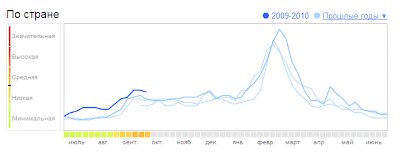Alla Zabrovskaya, director of public affairs for Google Russia.
Every year, flu kills hundreds of thousands of people, and millions suffer from it. Early detection of epidemics enables physicians to react quickly to the situation and save lives. Several years ago a group of Google engineers began working on models of aggregate queries, which can be like a mirror reflecting global trends and show what is happening around us. They reflect on the fact whether these models tell us, for example, or reducing the development of influenza activity in a particular country for a certain period of time.
service. Google Flu Trends. - Statistics of the spread of flu - was first launched in the U.S. in November 2008 and has established itself as a useful tool to assess the extent of influenza activity in a particular country in a real-time. Ability to monitor the dynamics of the epidemic has been helpful to zdravohranitelnyh organizations, doctors and ordinary users.
Today we are announcing the launch of this service in 16 countries, and hope that it will help health facilities to predict new outbreaks and to fight epidemics. Google Flu Trends uses. model based on the history of requests made for a long time, and compares them with the data provided. European Centre for Disease Prevention and Control.
In Russia, Google Flu Trends service is available in a pilot version. Despite the fact that to date the data was not backed by official statistics, we present an early version of the product and hope that it will provide the added source of information.
Many organizations working in health care, doctors are now using surveillance to track the development of epidemics. There may be a legitimate question -. why do we need to assess the cumulative search queries? . At the moment, Google Flu Trends data cover a range of countries and are updated every day, which can be a good complement to existing methods of monitoring.
For epidemiologists, this is a convenient way for early detection of disease outbreaks, which would reduce the number of cases. If, under certain conditions, a new strain of influenza virus, there is a likelihood of a pandemic with millions of deaths (as happened, for example,. 1918. ). Our data on the prevalence of influenza enable healthcare organizations and medical personnel in a timely manner to respond to seasonal epidemics and pandemics.
The aggregation of billions of requests since 2003, has created a workable model. This is an excellent example of beneficial use aggregated anonymous data. Statistics of search queries can be a source of valuable information on trends in the economy, health care and other areas. We have the tools. Google Insights for Search. , Which allows you to track the popularity level of a query - at different times and in different regions. So you can get ' inside look ' at the different areas of public interest. In the future we want to offer other opportunities to use these data for the common good.
The huge scale gives the user requests is unprecedented in scope picture of the world around us. John Battelle (. John Battelle). suggested that, in aggregate form requests users - it is ' a symbol of mankind's intention '. He argued that the database is able to reflect the needs and desires of people. Google Flu Trends - one of the examples of how queries can not only reflect what is happening in the world, but also to become an assistant in the fight against global challenges.


No comments:
Post a Comment